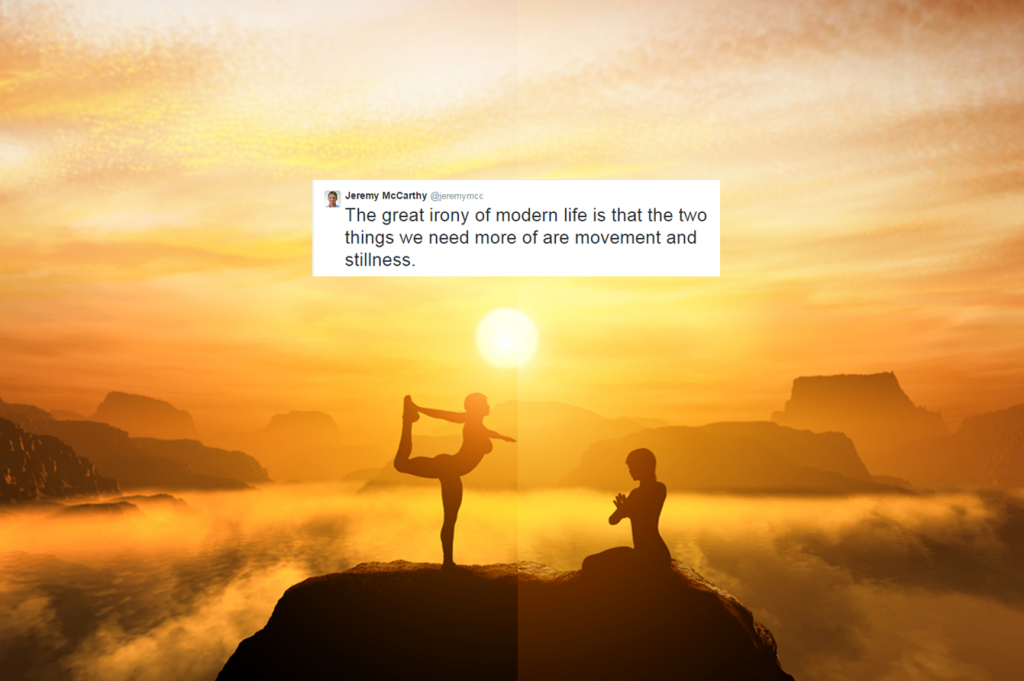 The greatest irony of modern life is that the two things we need more of are movement and stillness. Our bodies and minds evolved to live a life of balance between activity and rest, but modern lifestyle seems to prevent us from doing either very well.
The greatest irony of modern life is that the two things we need more of are movement and stillness. Our bodies and minds evolved to live a life of balance between activity and rest, but modern lifestyle seems to prevent us from doing either very well.
Modern conveniences and technology, for example, have stifled our movement patterns. We use cars, elevators and escalators to move us from point A to point B. When we do walk, we do so on paved paths that have been cleared so we don’t have to be concerned with uneven surfaces or obstacles to move over, under or around.
And we spend much of our time sitting in chairs, a modern (relatively speaking) invention designed to keep us comfortable. But we are becoming all too aware of the toll we are paying (“sitting is the new smoking” as the recent headlines tell us) with weak core muscles, shortened hip flexors, and poor posture.
The chair, along with the toilet, has made the “squat” inaccessible to the modern adult. This was a primal movement pattern that our ancestors could comfortably settle into for hours. I realize some will shrug, appreciating the modern contraptions that allow us to forego these more primitive means of movement. But again, we pay a price with tight calves and weak backs.
Luckily, the awareness of the need for movement is high, and so we try incorporating more of it into our lives. But participating in sports or following a specific fitness regime still locks us into limited movement patterns that cause imbalances and injuries in the body. We need a return to a diversity of movement that helped us evolve to the magnificent creatures we are today.
Only recently are we starting to recognize that, in addition to movement, we need stillness. Our bodies and minds need time to recover. Being “sedentary,” which many of us are, is not the same as being “rested,” a state that seems to elude us. We spend plenty of time with our bodies not engaged, but we try to squeeze productivity into every waking second by plugging our minds into technology.
Our ancestors did not have the option of constant productivity. They were forced into downtime during long walks in search of food and water, lengthy meal preparation times, and simply having more time at leisure (something we lost during the industrial revolution.)
Today, our new devices and technologies allow us to be connected every waking minute. But just because we can, doesn’t mean we should. We need to find time for disconnection, time for silence, and time for reflection. Not only does the body need time to rest, but the mind also needs time to recover and to process the vast amounts of data that come through in the age of information.
So we find ourselves in a strange contradiction, needing simultaneously to practice more movement and more stillness.
Some strategies you can try for increasing movement are:
- Bring more variety to your movement. Change your workout every week. Don’t play one sport, dabble in several. (See The Price of Specialization by Ido Portal.)
- Practice moving through nature in varied and unpredictable ways. (See MovNat and Parkour for inspiration.)
- Work on new movement patterns that have become lost to you: a squat, a handstand,or a cartwheel, for example. Always push the boundaries of your physical capabilities.
Some strategies for incorporating more stillness into your life are:
- Start a meditation practice.
- Create a stillness ritual that starts an hour before bedtime.
- Spend time with your family where you do nothing but be present for them.
- Practice a technology-free night in your home.
What do you need more of in your life? Movement, stillness . . . or both?

Loved the photo almost as much as the insightful text. Now I am off to MOVE in an unusual manner. This ought be good! Thanks for your perennial wisdom and noveau ideas, Jeremy.
Jeremy, this is so timely and oh so true! After having two kids in 19 months and the “noise” and activity that comes with that, I am in need of stillness. I used to meditate and do yoga daily: perfect blend of both stillness and movement. I no longer have that and I am re-designing what it means to have stillness now.
I still managed to sneak away and read your blog these past months, that counts for some stillness – right? 🙂
Very relevant, timely and perceptive, Jeremy. As a father of a teenager, a yoga and mindfulness teacher, and because of working in a school, I see the effects of the lack of the two elements in our daily life, in addition to the effects of the over-presence of the same two elements. It is encouraging to see mindfulness becoming more accepted in different arenas, as it is similarly encouraging to see the importance of movement being rediscovered, partly because of mindfulness being embraced. It is certainly a philosophy that needs to be instilled in the young by those leaders who nurture the young, and by emerging young leaders who have such a vastly different view than the generation preceeding them.
Heather, from your Yin yoga class, told me about your work and blog. I work with her on mindfulness at the school, and at the same club on Monday evenings. Would you mind contacting me at the email registered for this post? There is an event related to mindfulness in leadership that I feel you would be interested in, given your philosophy.
Am about to read your “Movement is the New Fitness” post, as I also am involved in MovNat in HK.